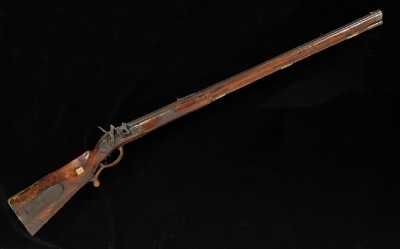149
361
363
379
377
152
150
176
182
365
230
369
371
174
374
357
165
154
340
327
179
158
347
337
160
227
342
159
356
183
359
360
339
324
178
170
171
334
335
167
181
148
380
157
177
168
349
172
316
319
163
378
381
370
156
Converted rifle (1884.27.68)
This hunting rifle was originally made as a flintlock weapon by Georg Drausmiller in Munich in 1729. It bears a typical German walnut stock and wooden trigger-guard, and the lock plate is inscribed with the German word Tugend meaning ‘virtue’. Like all early muzzle-loading rifles it also has a 'patchbox' in the stock which stored the bullets and patches.
Around one hundred years after its manufacture, it was converted to percussion and used in the Hungarian Revolution of 1848 (a failed attempt by the Kingdom of Hungary to gain independence from Austrian rule). The replacement lock is of an early (Forsyth) type with a long-nosed striker, which used a priming powder made of potassium chlorate and sulphur, instead of fulminate.





